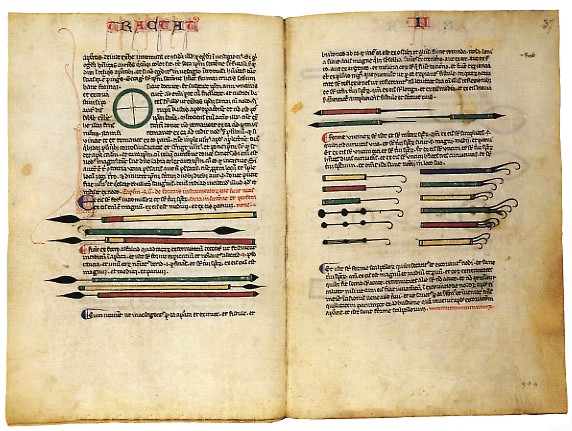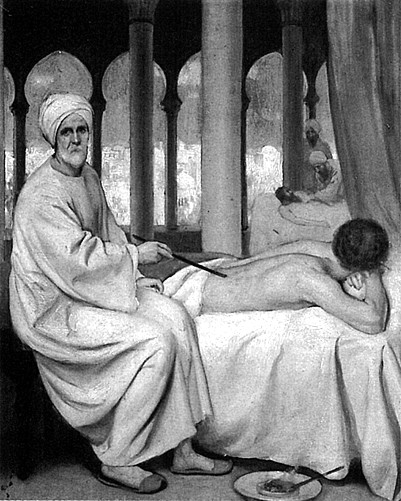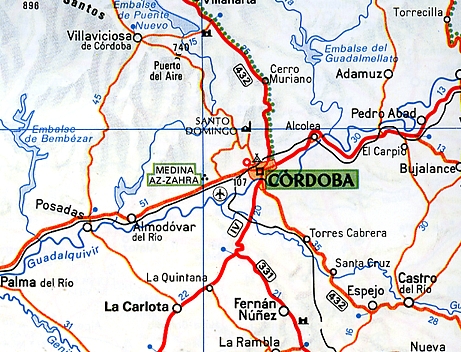Lessico
Albucasis
Abu al-Qasim Khalaf ibn al-Abbas Al-Zahrawi
Medico
spagnolo discendente della tribù araba Ansar, noto anche come Abulcasis e Alsaharavus
(Medinat al-Zahra presso Cordova 936-1013). Discepolo della scuola medica araba, fu forse il principale
trattatista di medicina chirurgica di quell'epoca. Scrisse una grande opera in
trenta volumi (al-Tasrif, La raccolta) che fu tradotta in latino nel
sec. XII da Gherardo da Cremona![]() .
.
Le sue teorie influirono a lungo sull'opera di medici e chirurghi europei. Particolare importanza riveste la descrizione di tecniche operatorie indubbiamente assai ardite per quei tempi (erniotomia, uso del catetere vescicale, applicazione di denti artificiali, cura di ferite da armi da taglio e da punta).

La Chirurgia di Albucasis tradotta da Gherardo da Cremona
Albucasis
936 ca. - 1013 ca.
Medico-chirurgo
dal
Dizionario biografico della storia della Medicina
Franco Maria Ricci - Milano - 1985

Albucasis
mentre cauterizza un Paziente
dipinto di E. Board - XX secolo
Albucasis è il nome sotto il quale il medico-chirurgo ispano-arabo Abu 'l-Quasim Khalaf ibn 'Abbas al-Zahrawi fu maggiormente noto nell’occidente latino. Tra le vane latinizzazioni del suo nome, oltre ad Albucasis, figurano Alsahavarius, Alzarabi e numerose altre. Le sue date di nascita e di morte non si conoscono con esattezza e occorre affidarsi alle scarse testimonianze disponibili.

Cordova, capitale del califfato, conobbe una vera rinascita architettonica, culturale ed economica grazie agli interessi del suo califfo Abd al-Rahman III (? 889-Cordova 961) che volle la nascita della Scuola di medicina e la costruzione della città-palazzo di Medinat al-Zahra (“la città in fiore”). Svariate sono gli attuali appellativi di questa città di cui non rimangono che resti assai interessanti: Medina az-Zahra, Medina Azahara, Zahara. Il che è stato fonte di una stressante ricerca toponomastica.
Gli antenati più diretti di Albucasis erano probabilmente giunti in Spagna dall’Arabia: una aggiunta al suo nome che ricorre in alcuni manoscritti, "al-Ansari", lascia supporre un’affiliazione alla città di Medina, in Arabia. In ogni caso il soprannome, al-Zahrawi, indica una stretta connessione alla città di al-Zahra nei pressi di Cordova. Egli fu al servizio del califfo Abd al-Rahman III (califfo dal 912 al 961), e, a quanto pare, ebbe modo di Compiere numerosi viaggi. La grande opera di Albucasis, Kitab al-Tasrif li man 'Ajaza 'an al-Ta'lif (approssimativamente traducibile come Libro per la guida di coloro che non sanno scrivere libri), risale probabilmente al 1000 e rappresenta il culmine di una carriera medica lunga e varia. All'infuori di questi scarni fatti, alcuni tra l’altro congetturali, più nulla ci è noto sulla vita dell’uomo la cui opera chirurgica fu destinata ad esercitare un enorme impatto sull'Occidente medievale.
Per quanto
ne sappiamo, Kitab al-Tasrif è
l'unico libro scritto da Albucasis. Consta di circa 1500 pagine (750 fogli),
ed è diviso in 30 capitoli o trattati; i trattati numero 1, 2 e 30 coprono
quasi la metà dell’opera. Gli argomenti abbracciano la fisiologia, le
malattie e i loro sintomi, la cosmetica, la dietetica, mentre circa 25
trattati riguardano temi di farmacologia e materia medica. Il trattato numero
30, il più celebrato di tutti, si occupa di chirurgia. In esso vengono
descritte operazioni di calcoli, cauterizzazioni di ferite, suture, procedure
ginecologiche e odontoiatriche, nonché riduzioni di fratture e cure delle
distorsioni. Uno dei motivi di maggior interesse dell’opera è costituito
dalle sue 200 illustrazioni di strumenti medici e odontoiatrici, molte delle
quali disegnate dallo stesso autore. Alcuni sostengono (tra cui Albucasis
stesso) che la maggior parte di questo materiale è stata attinta dalle opere
di Paolo di Egina![]() ,
ma senza dubbio il trattato incorpora sia l’esperienza accumulata da
praticanti arabi successivi, sia le innovazioni personali dell’autore.
,
ma senza dubbio il trattato incorpora sia l’esperienza accumulata da
praticanti arabi successivi, sia le innovazioni personali dell’autore.
Il trattato numero 30 acquisì enorme fama nell'Occidente medievale. Nella seconda metà del XII secolo venne tradotto in latino da Gherardo da Cremona; i trattati numero 1, 2 e 28 vennero anch’essi tradotti in latino nel XIII secolo, ma non assursero mai alla fama del numero 30. Quest’ultimo venne pubblicato numerose volte, spesso come appendice al manuale di chirurgia di Guy de Chauliac (Venezia 1497, 1499, 1500 e 1532). Chauliac (chirurgo e anatomista francese, Chauliac ca. 1290 - forse Lione 1368) nomina il testo di Albucasis più volte, citando direttamente da esso. Per questa e altre vie le idee di Albucasis seguitarono a influenzare la medicina occidentale fino al XVIII secolo.
La prima edizione a stampa del trattato apparve a Basilea nel 1541. L’edizione araba e latina, a opera di John Channing, fu stampata a Oxford net 1778. Più recentemente, Leclerc ha tradotto in francese il trattato sulla chirurgia (1861), mentre nel 1973 Spink e Lewis ne hanno pubblicato il testo arabo con traduzione inglese a fronte. Il libro non è stato però mai pubblicato a stampa nella sua interezza.
Al-Zahrawi
- Albucasis
A light in the dark middle ages in Europe
"without
doubt Albucasis was the chief of all surgeons“
(Pietro Argallata)
Dr.
Sharif Kaf Al-Ghazal
MD, MS, RCS (Plast.Cert.), DM (Plast)
Plastic , Reconstructive & Hand Surgeon
England
Abu
al-Qasim Khalaf bin Abbas Al-Zahrawi (A.D. 936-1013), known to the West by his
Latin name Albucasis, was born in Al Zahra’a , six miles northwest of
Cordoba in Andalusia. He was
simply the greatest Muslim surgeon, with European surgeons of his time coming
to regard him as a greater authority than even Galen, the ancient world's
acknowledged master. It is clear from Al-Zahrawi's life history and from his
writings that he devoted his entire life and genius to the advancement of
medicine as a whole and surgery in particular.
What is known about Al-Zahrawi is contained in his only written work:
At-Tasrif liman 'Ajiza 'an at-Ta'lif (The Method of Medicine). At-Tasrif is a
medical encyclopaedia compendium of 30 volumes compiled from medical data that
Al-Zahrawi accumulated in a medical career that spanned five decades of
teaching and medical practice. He apparently travelled very little but had
wide experience in treating accident victims and war casualties.
The last and largest volume of At-Tasrif, "On Surgery," was nothing less than the greatest achievement of medieval surgery. It was the first independent surgical treatise ever written in detail . It included many pictures of surgical instruments, most invented by Al-Zahrawi himself, and explanations of their use. Al-Zahrawi was the first medical author to provide illustrations of instruments used in surgery. There are approximately 200 such drawings ranging from a tongue depressor and a tooth extractor to a catheter and an elaborate obstetric device.
The variety of operations covered is amazing. In this treatise Al Zahrawi discussed bloodletting, midwifery and obstetrics , the treatment of wounds , the extraction of arrows and the setting of bones in simple and compound fractures. He also promoted the use of antiseptics in wounds and skin injuries; devised sutures from animal intestines, silk, wool and other substances . He described the exposure and division of the temporal artery to relieve certain types of headaches, diversion of urine into the rectum, reduction mammoplasty for excessively large breasts and the extraction of cataracts.
He wrote
extensively about injuries to bones and joints, even mentioning fractures of
the nasal bones and of the vertebrae , in fact 'Kocher's method' for reducing
a dislocated shoulder was described in At-Tasrif long before Kocher was born !
Al-Zahrawi outlined the use of caustics in surgery, fully described
tonsillectomy, tracheotomy and craniotomy operations which he had performed on a dead foetus.
He explained how to use a hook to extract a polyp from the nose, how to use a bulb syringe he had invented for giving enemas to children and how to use a metallic bladder syringe and speculum to extract bladder stones.
Al Zahrawi was the first to describe the so-called "Walcher position" in obstetrics; the first to depict dental arches, tongue depressors and lead catheters and the first to describe clearly the hereditary circumstances surrounding haemophilia. He also described ligaturing of blood vessels long before Ambroise Pare.
Al-Zahrawi
is the first to detail the classic operation for cancer of the breast,
lithotrities for bladder stones, and techniques for removing thyroid cysts.
He was considered one of the early leading “plastic surgeon” as he
performed many plastic surgery procedures. In the 11th chapter of volume 30 of
his book he put many principles in that surgical field . He used ink to mark
the incisions in his patients preoperatively which became now as a routine
standard procedure . In (chapter 26 ) he explained the differences between
primary and secondary wound closure and also the importance of wound
Debridement before closure.
In (chapter 47 ) he described the surgical options to treat Gynecomastia as he recommended removal of the glandular tissue by a C-shaped incision. For large breasts with excess skin that cannot be corrected with glandular excision alone, “...make two incisions so that the edges join each other, then remove the skin and glandular tissue in between and suture the edges of the defect...” . This technique is still considered for such condition nowadays.
Al-Zahrawi had a special interest in eyelid surgery.
He gave sensible suggestions on the use of fine instruments, of which he had a wide variety. He described surgical management of different pathologies such as entropion, ectropion, trichiasis and symblepharon.
In the treatment of entropion, Al Zahrawi advised eversion of the eyelid with fingers or with a traction suture. An incision under the eyelashes from medial to lateral is then carried out so that the skin is separated from the lid margin. A leaf-shaped piece of eyelid skin is excised, and lash eversion is achieved as the defect is sutured primarily.
He also classified ectropion as congenital and acquired and he advised eversion and resection of a base-down triangular segment from the inner layers for lower lid laxity to treat to cases of eye ectropion.
His book
At-Tasrif is also the first work in diagramming surgical instruments,
detailing over two hundred of them, many of which Al-Zahrawi devised himself.
Many of these instruments, with modifications, are still in use today.
Once At-Tasrif was translated into Latin in the 12th century, Al Zahrawi had a
tremendous influence on surgery in the West. The French surgeon Guy de
Chauliac in his 'Great Surgery', completed in about 1363, quoted At-Tasrif
over 200 times.
With the reawakening of European interest in medical science, At-Tasrif quickly became a standard reference and was translated into Latin five times. The arrangement of the work, its clear diction, and its lucid explanations all contributed to its popularity and great success.
Al Zahrawi was described by Pietro Argallata (died 1423) as "without doubt the chief of all surgeons". Jaques Delechamps (1513-1588), another French surgeon, made extensive use of At-Tasrif in his elaborate commentary, confirming the great prestige of Al Zahrawi throughout the Middle Ages and up to the Renaissance.
Selected References
1. Hamareh
S K in The Genius of Arab Civilisation edited by J R Hayes; 2nd edition, 1983;
Eurabia (Publishing) Ltd; pp 198-200
2. Albucasis; On Surgery and Instruments; English translation and commentary .
by Spink M S and Lewis G L; 1973
3. El Zahrawi (Albucasis) - father of surgery . by Dr. Monzur Ahmed
4.Az-Zahrawi: The Great Surgeon. by David Tschanz
5. Al-Zahrawi and Plastic Surgery. By Dr.Sharif Kaf Al-Ghazal. ArabMed
Journal, Issue 2(12); 2002. Page
16-18
6- Al Zahrawi and his influence on eye surgery. Dr. M.Zafer Wafawi.
7- Islamic Medicine On Line: http://www.islamicmedicine.org/